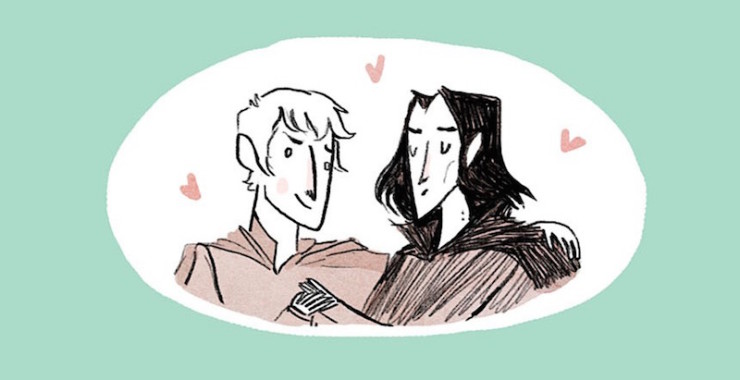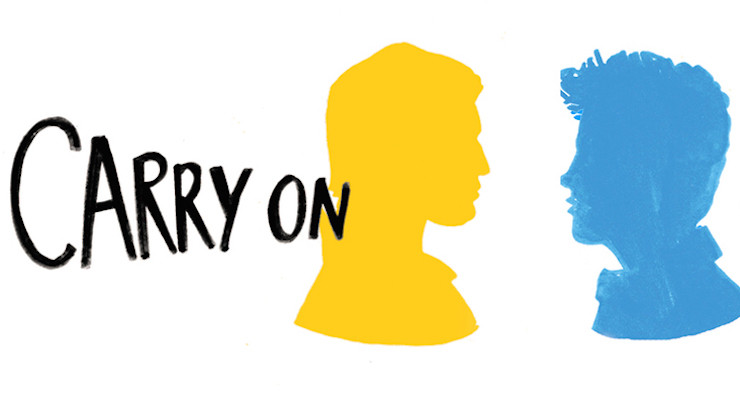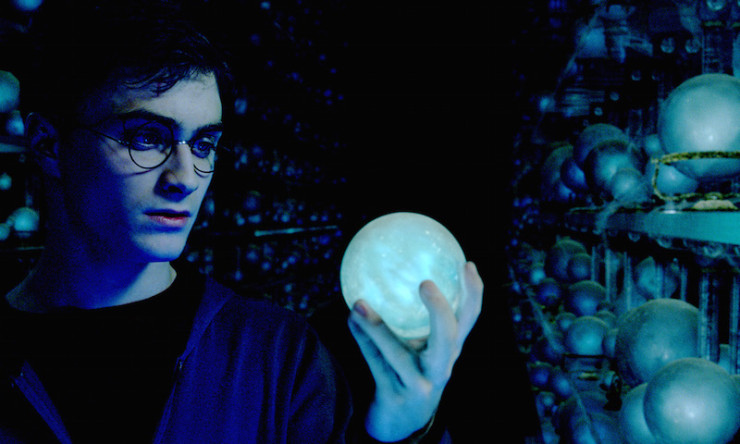From page 1, you can’t read Rainbow Rowell’s Carry On without thinking of Harry Potter. At the start of the book, eighteen-year-old Simon Snow is leaving behind the Normal world for another school year at the Watford School of Magicks, reflecting on the Humdrum’s latest failed attempt to kill him and agonizing over the pressures of being the magical community’s Chosen One. It basically follows the blueprint for one of the world’s most famous book series.
And that’s OK! Rowell initially did use J.K. Rowling’s series and her Boy Who Lived as the background to explain Cath’s Simon Snow fanfiction in her 2013 YA novel Fangirl. This shorthand undoubtedly made the book more relatable for readers who may not have understood the culture of fanfic. When Rowell decided to delve deeper into Simon’s world for Carry On, the Potter canon was a baseline from which she made major deviations in order to say some wholly original things about Chosen One narratives, self-fulfilling prophecies, queerness, and modern magic. Reading Carry On makes me remember one of my absolute favorite aspects of early-2000s fanfic culture.
Some spoilers for Carry On.
Modern fandom’s tendency to retweet and reblog content has its roots in the fanfiction community’s tradition of remixing and reduxing stories. Starting in 2003, fanfic authors, not unlike music producers, remixed one another’s work. There were a few ground rules: You couldn’t change the basic plotline, the setting, or the pairing (whether by swapping in new characters or making a het pairing slash, or vice versa). But from there, anything goes! Those who got matched with their favorite writers got to turn the story over in their hands, to add or subtract characters, to layer new themes or motifs over the preexisting plot. The results were often enchanting, as new POVs were revealed or remixers introduced techniques that match the original story while bringing in a new dimension. LiveJournal user musesfool, moderator of the LJ community remixredux, explains the process wonderfully, emphasizing that it’s not about “fixing” the story. Instead, it’s about the writer putting his/her stamp on the story: “teasing out hidden meanings from the interstices, the word left unsaid, the meaningful glance… Take a chance make a mess.” One of my favorite parts was reading the out-there titles, like Mastermind (The Mother Knows Best Remix), or Free Range Subjects (The Scientific Method Remix).

These remixes had such personality! They simultaneously put the original work up on a pedestal and took it down a peg. Everything was sacred—considering these fanfics affected readers enough that they wanted to write their own interpretation—and nothing was sacred. While I’m sure that there have been writers who haven’t appreciated how the remixes came out, in the years that I read them, the response was overwhelmingly positive. Riffing on each other brought everyone closer.
With this book, Rowell has (unintentionally, I imagine) remixed the Harry Potter books into something entirely fresh and modern. So, what would we call this—Carry On (The You Were the Sun, and I Was Crashing Into You Remix)?
Some background: First came Fangirl, in which the Simon Snow passages were cutesy interludes bookending the main plot points. In-between Cath’s anxiety about starting freshman year of college, her twin sister (and former fanfic co-writer) Wren choosing to live with someone else, her struggles to write original fiction for class, and her sweet moments teaching Levi to read, we got glimpses into Simon Snow’s world. These came in the form of excerpts from fictional author Gemma T. Leslie’s (the Rowling analog) books and selections from Cath and Wren’s much-beloved magnum opus fanfic Carry On, Simon. But despite the proliferation of passages, the details were barely skin-deep. No judgment on Rowell, because I know the feeling; I’m writing a play about live-action role-playing, and in my first draft I’ve mostly cribbed from a handful of larps I’ve heard about, to create an amalgam that’s deceptively shallow. It stands in for the necessary metaphors in the play’s overall plot, without spending too much time delving into the mechanics of the larp. Fangirl‘s depiction of Simon Snow did much the same.
Rowell acknowledged this in a recent interview with The Toast: “I think I felt like I’d created these characters and this whole world, but I’d never gotten to play around in it. In Fangirl, I was always writing about Simon and Baz through other characters. They were a device, really. A book within a book. A painting on the wall inside a larger painting.” She intended to write something short—”a 10,000-word short story showing Simon and Baz falling in love”—just to get it out of her system. Instead, she got her first fantasy novel.

A major distinction that Rowell made, in the months before Carry On came out, was that this was a third take on Simon Snow. It wasn’t Gemma T. Leslie’s canonical series, and it wasn’t Cath’s fanfiction; it was Rowell, playing in this world after having handed the reins to two fictional authors. And part of reclaiming her own creation was taking the Potter elements and exploding them into a modern fairy tale. Here I’d like to quote The Daily Dot’s resident fandom reporter Aja Romano, who puts it so succinctly in her book review:
Carry On utilizes so, so many of the plot points of Harry Potter. So many of the trappings of Potterdom are here: awkwardly backward wizarding customs; Simon’s mysterious parentage and a prophecy decreeing him the chosen one; the deadly forest and banal animal caretaker both inexplicably on school grounds; class hierarchy between the magicians and other magical creatures; Simon’s outsider status as the only “Normal”-born magician; his enmity with the aristocratic and sinister Baz, whose ancient and powerful family is at war with Simon’s equally powerful protector, the Mage; the presence of a strange figure called the Humdrum, which has apparently tried to kill Simon every year since he’s attended the Watford School of Magicks; and many more.
…But Rowell doesn’t just parrot these ideas. Instead she uses them to directly address countless criticisms that HP fans have leveled at the series over the years: Dumbledore’s mistreatment of Harry; the lack of significant characters of color; the lack of any queer characters at all; the lack of ambiguity between the “good” and “evil” Hogwarts houses and the pointlessness of labeling a child for life before they’ve even been through puberty; the misjudgments of Harry himself about the people around him; the lack of narrative agency given to characters ranging from Hagrid to Ginny Weasley. The tropes in Carry On are narrative versions of the criticisms I’ve leveled at Rowling’s texts for years, in everything from fanfics of my own to Tumblr tags (“I’ve got 99 problems and J.K. Rowling’s unintentional meta-narrative is all of them”).
As in the Potter series, the protagonists of Carry On make up a terrific trio, but in this case the gender balance is flipped. Penelope is very clearly Hermione, with her ingrained smarts and belief that everyone else is just thick, and her no-nonsense way of getting past no-girls-allowed wards, but here’s a twist: She’s Indian. In what has to be a nod to the fan theories about Hermione being a woman of color, Penny challenges suggestions that she have a more “ethnic” name like Saanvi with “Someone like me can be named anything.” She’s also often identified by her hair, but in this case it’s for its wild colors instead of its bushiness. Yet Penny has a lot of the Weasleys in her, and not just her penchant for bright red locks: Her parents, both professors and former Watford students, move through the magical world not unlike Arthur Weasley with his Ministry job.

Simon’s girlfriend Agatha has the looks of Fleur Delacour mixed with the insecure-verging-on-sadsack brooding of Cho Chang… but who can blame her? She’s in the situation Ginny might have found herself in had she nabbed Harry early on—and she likely would also have hated being treated as the prize that Simon gets if he manages to survive graduation without getting incinerated. Unlike Simon, who blocks out his summers in the Normal world between terms at Watford, Agatha yearns to be a normal teenager.
And then there’s Baz. Ohhh, dear Tyrannus Basilton Pitch. Remember how tortured Draco was in Harry Potter and the Half-Blood Prince, and how you almost burst into tears when mean old Harry performed Sectumsempra on him? (Just me? OK.) So, Baz has been that tortured basically since he started at Watford as an eleven-year-old. He’s got his family riding him about pureblood politics, except that the Grimm-Pitch line died out when he was a child, on account of Baz getting turned into a vampire. Though that didn’t manifest until puberty, so we’ve got a bit of a Remus Lupin deal, except Baz didn’t have any buddies who were willing to transform into animals to help him out with his problem. And the bloodlust isn’t three days a month, it’s every night. When I say the line died out with him, his mother Natasha Grimm-Pitch also perished—so it’s not Simon who’s carrying the baggage of a dead mother, it’s Baz. (Simon is an orphan, but his parents’ fates are unclear.) On top of that, Baz has been in love with Simon for most of the time that they’ve been roommates. So, naturally, he hides all of these feelings by trying to take Simon out every chance he gets—very Snape-like of him, though his ulterior motives are far different.
Did I mention that this book has at least eight different narrators? Unlike the Potter books, which take place entirely through Harry’s perspective—with the occasional dip into someone else’s memories via the Pensieve—Simon is just one of many voices narrating Carry On. It makes for great dramatic irony, especially when we find out why Baz missed the first few weeks of school (his absence having nearly driven Simon insane), and how out of place Agatha feels among the other aspiring magicians. And since this book smushes the prophecies and ghosts and world-ending magic of the Potter series into just one volume, we also get chapters from the POVs of ghosts parting the Veil to visit Watford students, and from Simon’s enigmatic protector, the Mage.
The biggest way in which Rowell deviates from Rowling is in the Chosen One narrative… and dare I say, I might prefer Rowell’s version. Both stories start from the same point: An orphan has barely enough time to accept the existence of a whole hidden, magical world, before he also finds out that he’s that world’s biggest celebrity. But for as much angst as Harry has about the expectations and biases heaped on him, he mostly stumbles his way into triumphs: Mysterious benefactors send him expensive broomsticks, the Sword of Gryffindor materializes in the Sorting Hat right when he needs it, a supposed enemy turns into a surprise godfather—not to mention that every time he gets dropped into a surely fatal situation, he finagles a way out.
Then there’s Simon, who basically just explodes every time he’s threatened. This poor kid is pure magic, and despite seven years of Watford study, he hasn’t learned how to control it beyond yelling at people to duck and cover. The catalog copy glibly describes him as “the worst Chosen One who’s ever been chosen,” but it’s actually true. Penny compares using her magic to drawing water up from a well; for Agatha, it’s flexing a muscle like in ballet; Baz’s is like lighting a match or pulling a trigger; Simon just goes off like a bomb. It’s a keen way to express how much Simon feels set apart from his peers; while they interact with their magic, he cannot be set apart from his. He’s a living weapon, not good for much else besides fighting the Humdrum. In fact, Simon makes a more relatable role model for Millennial readers than Harry ever did: While Harry co-founds Dumbledore’s Army, works with the Order of the Phoenix, and becomes an Auror with a certain sense of purpose, Simon is essentially just dicking around, with absolutely no idea what’s in store for him after Watford.
Both Harry and Simon, as we meet them at the beginning of their respective series, are birthed by self-fulfilling prophecies—but Simon’s origin story is much more literal. Delving into Carry On spoilers here, so read on at your own risk. With Harry Potter and the Order of the Phoenix, we discovered that Neville Longbottom and Harry were both contenders for Sybil Trelawney’s prophecy, but that the moment Voldemort decided to go after Harry (because he saw himself in the half-blood baby) was what sealed both their fates. It all comes down to the wording in the prophecy: “…and the Dark Lord will mark him as his equal, but he will have power the Dark Lord knows not…” Only after Lily sacrifices her life for Harry, making the killing curse backfire, does he absorb some of Voldemort’s powers and get marked with the lightning-bolt scar—both of which transform him into Voldemort’s equal.
But as we’ve established, both Harry and Neville were already alive when Voldemort heard the prophecy and came looking to snuff out his supposed infant rival. Rowell takes the notion of a self-fulfilling prophecy way further by having the Mage (imagine a younger, rasher Dumbledore dressed as Peter Pan) obsess over a prophecy he discovers, repeated over and over by oracles, while a student at Watford:
And one will come to end us.
And one will bring his fall.
Let the greatest power of powers reign,
May it save us all.
But seeing as there’s no dark lord peeking in cradles for powerful babies, the Mage comes to interpret the prophecy as something else entirely: “What if the oracles kept having the same visions because they weren’t prophecies at all? What if they were instructions? Lucy—what if they’re meant to guide us to change, not foretell it? Here we are, just waiting to be saved, but the prophecies tell us how to save ourselves!” And how does he plan on saving the magical world? By conceiving the Great Mage through his long-suffering girlfriend (the aforementioned Lucy) and creepy dark magic rituals involving nonhuman blood.
Poor Simon Snow (named for the weather on the night he was abandoned at the orphanage) never had a chance at a normal life. At least Harry can always ponder what would have been if Voldemort had dropped in on the Longbottoms instead of the Potters; Simon’s fate was sealed the moment the Mage read that prophecy. Not to take the Millennial metaphor too far, but Simon (who would have been born in the late ’90s, nearly a generation after Harry) belongs to the generation who grow up feeling like they have no control over their job prospects after school.

Rowell does break one rule of the remix, but it makes the book better: She changes the pairing. Part of what endeared Fangirl readers to Simon Snow was that Cath and Wren happily slashed him with Baz, mirroring the Potter fandom’s love for Harry/Draco. If I remember Fangirl correctly, that slash pairing was more fanfic writers’ wishful thinking than Gemma T. Leslie’s canon, but Rowell’s take in Carry On is the one that will be best remembered for queering a boy wizard. Rowell isn’t afraid to challenge the kinds of heteronormative, “boy must marry girl because future generations” romances we see in fantasy novels: Over the course of the book, two boys who have tried multiple times to kill one another explore the possibility that this whole time they’ve been falling in love instead. Sexuality isn’t cut-and-dried, it’s fluid—a notion that was nowhere near as mainstream during either Harry’s lifetime or the time period of the books’ publication. (One quibble: Simon, in agonizing over his sexuality, decides that he must be gay now. Why not make him bisexual?)
So, that’s one major deviation from the tenets of remixing, but one I’m willing to forgive. Harry Potter and Carry On were written in such different generations that adding an LGBT angle to the narrative reflects today’s diversity in gender and sexuality conversations. In short, while many of us cut our teeth on Harry Potter fanfiction, Carry On really is written for those of us who dreamt of our own takes on the Potterverse.
Finally, Carry On is about the power of words. Magicians use wands (or rings, or belt buckles) to channel their magic, but the true power comes out of their mouths. Rather than have the incantations shaped by dead languages with annoyingly specific pronunciation, every spell in Simon Snow’s world is a popular phrase: nursery rhymes, song lyrics, catchphrases, aphorisms, modern slang. Magic words lose impact if their namesake phrases fall out of popular use, and young magicians regularly try to bring new spells into use. (But, as with “fetch,” few catch on permanently.) Whereas I find myself still having to Google any Hogwarts spells that aren’t Wingardium Leviosa and Avada Kedavra, it’s much easier to remember Come out, come out, wherever you are! and It is what it is!
It’s this emphasis on words, on the enduring power of some phrases and the need to mix up others into something new, that makes Carry On have a special place in my heart, and (I hope) a revered spot in both fanfic and Harry Potter canons. And who knows—perhaps the success of Carry On and precedents like Pride and Prejudice and Zombies could lend greater credence to the notion of remixing and give it a proper place in publishing.
Natalie Zutter now wants to remix a bunch of Firefly and Tamora Pierce fanfics from the early ’00s. You can read more of her work on Twitter and elsewhere.











